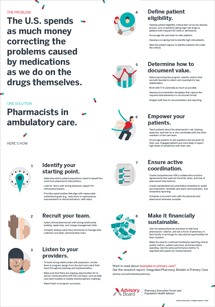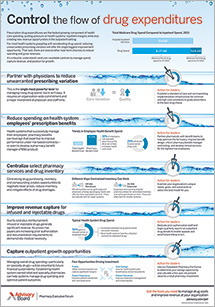Auto logout in seconds.
Continue LogoutThe United States far outspends other wealthy nations on prescription drugs, but a recent Health Affairs study shows that the trend dates back only to 1997—and by examining the causes of the 1990s spending spike, we may be able to shed light on the future of drug spending, Austin Frakt writes for the New York Times' "The Upshot."
The year US drug spending began to explode
According to data from the Commonwealth Fund, U.S. spending on retail prescription drugs was fairly typical until the late 1990s. Then, something strange happened: U.S. drug spending tripled between 1997 and 2007.
Spending then briefly leveled off before spiking again starting in 2013. By 2015, U.S. spending on prescription drugs had reached about $1,000 per person, far higher than in other developed nations. Switzerland, for example, had the second highest spending in 2015 at $783 per person, while Sweden had the lowest at $351.
So what caused the sudden spike? Frakt notes that several proposed explanations don't hold water. For instance, the problem isn't that Americans take more drugs than their peers in other countries. In fact, a recent study published in Health Policy found Americans use prescription drugs 12% fewer days a year than residents of other countries.
Further, the high spending isn't caused by heavier use of brand name drugs. Frakt notes that 84% of prescriptions in the United States are for generic drugs—a higher percentage than in other countries.
The real culprit behind the 1990s spending spike: New drugs—and no cost control
The real explanation for the spike, according to Frakt, is the United States in the late 1990s began paying more for newer drugs.
According to a recent study in Health Affairs, new hypertension and cancer drugs that hit the market in the 1990s fetched especially high price tags. As a result, the number of drugs with more than $1 billion in sales rose from six in 1997 to 52 in 2006.
Even though the new drugs were made available in many countries, they hit U.S. drug spending especially hard because, as Frakt notes, the United States didn't have cost-control policies to deny reimbursement for drugs with costs out of line with their effectiveness.
Michelle Mello, a health law scholar at Stanford University, said, "[W]e're largely uncritical of the price-value trade-off for drugs in the U.S. Though we pay high prices for some drugs of high value, we also pay high prices for drugs of little value. The U.S. stands virtually alone in this."
Additionally, Frakt notes the prescription drug spending spike correlates with expansions of drug coverage under Medicaid and the Children's Health Insurance Program. According to Frakt, research has shown that when the potential market for drugs gets bigger, more drugs enter into that market.
Aaron Kesselheim, an associate professor of medicine at Harvard Medical School, said the spike in drug spending also correlated with an increase in advertising to physicians and consumers.
So why did spending (briefly) level off in 2007?
Although the U.S. spending spike lasted for two full decades, Frakt notes that U.S. drug spending experienced a stark slowdown in 2007.
What explains this mystery? According to Frakt, the answer is fewer FDA approvals of new drugs. Drug approvals fell from around 35 per year in the late 1990s to 20 per year between 2005 and 2007.
Also, around that time, patents for top-selling drugs expired, which led to an increase in usage of generics, Frakt writes.
What's next for US drug spending?
Frakt notes that the latest U.S. drug spending spike "mirrors that of the 1990s," as it aligns with the introduction of new specialty drugs for hepatitis C, cystic fibrosis, and others.
Peter Bach, director of the Center for Health Policy and Outcomes at Memorial Sloan Kettering Cancer Center said, "Many of the new agents are biologics. These drugs have no meaningful competition, and therefore command very high prices." Bach added there's also been "a lowering of approval standards," meaning "more of these new, expensive drugs are making it to market faster."
There's some reason to believe that policymakers may take steps to rein in drug spending, Frakt notes. Democrats have long called for government policies to cut drug spending, and recently, the Trump administration and industry stakeholders have begun to take measures to cut costs. To Frakt, these are "early signs that attitudes [about drug spending] might be changing"
Even so, Rachel Sachs, an associate professor of law at Washington University who studies drug pricing, predicted "things will get worse before they get better" (Frakt, "The Upshot," New York Times, 11/12/18).
Five ways to control the flow of drug expenditures
Prescription drug expenditures are the fastest growing component of health care spending. And while reducing unwarranted prescribing variation is the single biggest improvement opportunity, there are several other near-term chances to reduce spending and grow revenues.
Don't miss out on the latest Advisory Board insights
Create your free account to access 1 resource, including the latest research and webinars.
Want access without creating an account?
You have 1 free members-only resource remaining this month.
1 free members-only resources remaining
1 free members-only resources remaining
You've reached your limit of free insights
Become a member to access all of Advisory Board's resources, events, and experts
Never miss out on the latest innovative health care content tailored to you.
Benefits include:
You've reached your limit of free insights
Become a member to access all of Advisory Board's resources, events, and experts
Never miss out on the latest innovative health care content tailored to you.
Benefits include:
This content is available through your Curated Research partnership with Advisory Board. Click on ‘view this resource’ to read the full piece
Email ask@advisory.com to learn more
Click on ‘Become a Member’ to learn about the benefits of a Full-Access partnership with Advisory Board
Never miss out on the latest innovative health care content tailored to you.
Benefits Include:
This is for members only. Learn more.
Click on ‘Become a Member’ to learn about the benefits of a Full-Access partnership with Advisory Board
Never miss out on the latest innovative health care content tailored to you.


